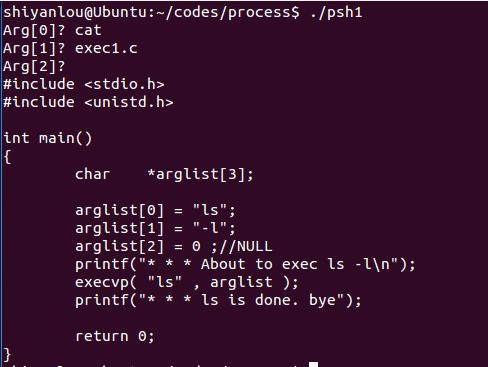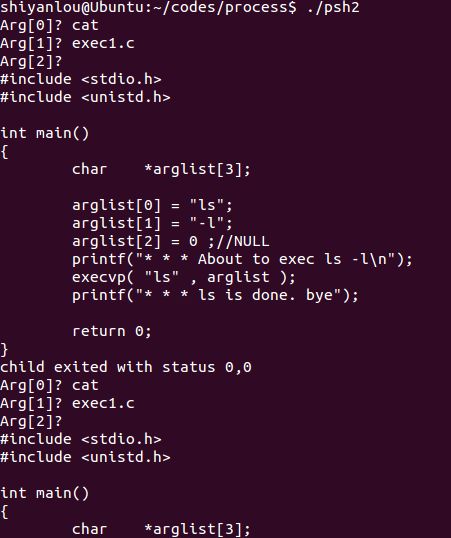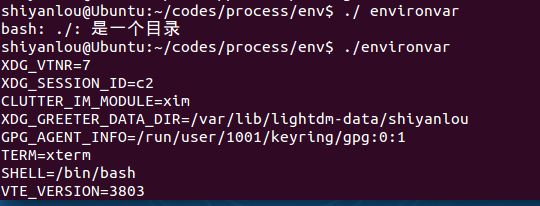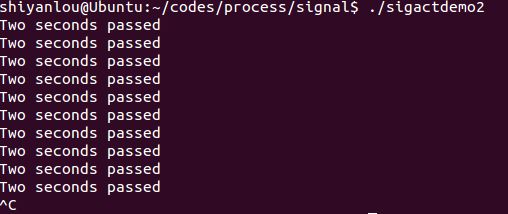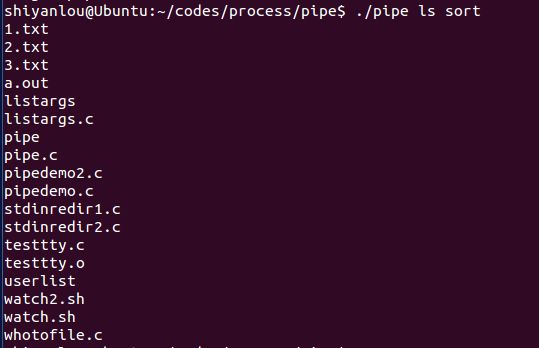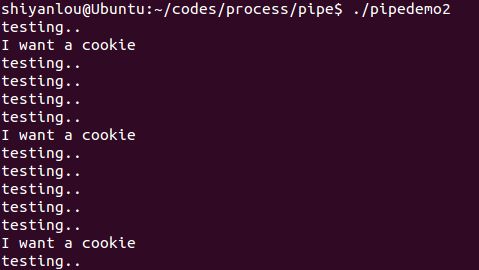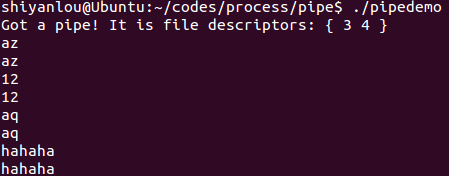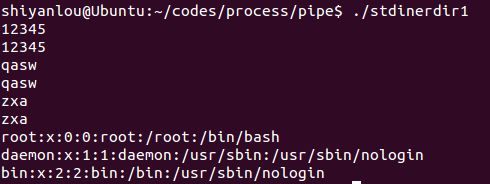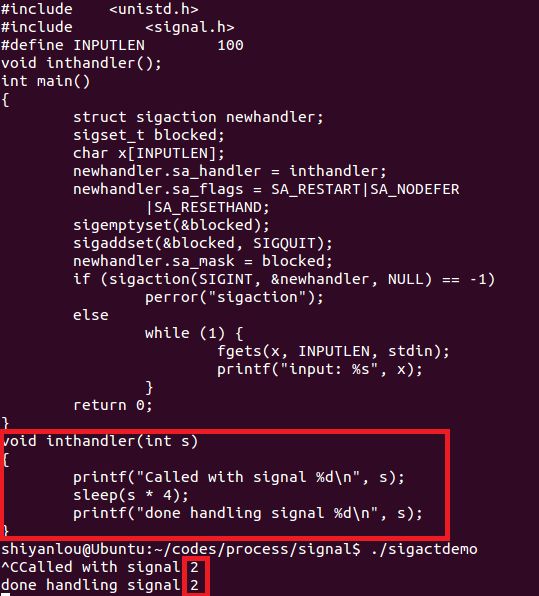进程&信号&管道实践学习记录
程序分析
exec1.c & exect2.c & exect3.c
程序代码 (以exect1.c为例,其他两个结构类似)
#include <stdio.h>
#include <unistd.h>
int main()
{
char *arglist[3];
arglist[0] = "ls";
arglist[1] = "-l";
arglist[2] = 0 ;//NULL
printf("* * * About to exec ls -l\n");
execvp( "ls" , arglist );
printf("* * * ls is done. bye");
return 0;
}运行结果:

结果显示代码“* * * ls is done. bye”没有打印出来。
原因:因为调用execvp,execlp,execv时,内核将新程序载入到当前进程,替代当前进程的代码和数据。
forkdemo1.c
程序代码:
#include <stdio.h>
#include <sys/types.h>
#include <unistd.h>
int main()
{
int ret_from_fork, mypid;
mypid = getpid();
printf("Before: my pid is %d\n", mypid);
ret_from_fork = fork();
sleep(1);
printf("After: my pid is %d, fork() said %d\n",
getpid(), ret_from_fork);
return 0;
}运行结果:
分析:fork()在父进程中返回子进程的pid,在子进程中返回0。
forkdemo2.c
程序代码:
#include <stdio.h>
#include <unistd.h>
int main()
{
printf("before:my pid is %d\n", getpid() );
fork();
fork();
printf("aftre:my pid is %d\n", getpid() );
return 0;
}运行结果:
分析:两次fork()共产生3个子进程,加上父进程总共有4个进程。
forkdemo3.c
程序代码:
#include <stdio.h>
#include <stdlib.h>
#include <unistd.h>
int main()
{
int fork_rv;
printf("Before: my pid is %d\n", getpid());
fork_rv = fork(); /* create new process */
if ( fork_rv == -1 ) /* check for error */
perror("fork");
else if ( fork_rv == 0 ){
printf("I am the child. my pid=%d\n", getpid());
exit(0);
}
else{
printf("I am the parent. my child is %d\n", fork_rv);
exit(0);
}
return 0;
}运行效果:
forkdemo4.c
程序代码:
#include <stdio.h>
#include <stdlib.h>
#include <unistd.h>
int main()
{
int fork_rv;
printf("Before: my pid is %d\n", getpid());
fork_rv = fork(); /* create new process */
if ( fork_rv == -1 ) /* check for error */
perror("fork");
else if ( fork_rv == 0 ){
printf("I am the child. my pid=%d\n", getpid());
printf("parent pid= %d, my pid=%d\n", getppid(), getpid());
exit(0);
}
else{
printf("I am the parent. my child is %d\n", fork_rv);
sleep(10);
exit(0);
}
return 0;
}运行结果:
forkgdb.c
程序代码:
#include <stdio.h>
#include <stdlib.h>
#include <unistd.h>
int gi=0;
int main()
{
int li=0;
static int si=0;
int i=0;
pid_t pid = fork();
if(pid == -1){
exit(-1);
}
else if(pid == 0){
for(i=0; i<5; i++){
printf("child li:%d\n", li++);
sleep(1);
printf("child gi:%d\n", gi++);
printf("child si:%d\n", si++);
}
exit(0);
}
else{
for(i=0; i<5; i++){
printf("parent li:%d\n", li++);
printf("parent gi:%d\n", gi++);
sleep(1);
printf("parent si:%d\n", si++);
}
exit(0);
}
return 0;
}运行效果:
分析:运行结果说明了子进程与父进程并发运行。
psh1.c
#include <stdio.h>
#include <stdlib.h>
#include <string.h>
#include <unistd.h>
#define MAXARGS 20
#define ARGLEN 100
//将字符串内容当做命令来执行。
int execute( char *arglist[] )
{
execvp(arglist[0], arglist);
perror("execvp failed");
exit(1);
}
char * makestring( char *buf )
{
char *cp;
buf[strlen(buf)-1] = '\0';
cp = malloc( strlen(buf)+1 );
if ( cp == NULL ){
fprintf(stderr,"no memory\n");
exit(1);
}
strcpy(cp, buf);
return cp;
}
int main()
{
char *arglist[MAXARGS+1];
int numargs;
char argbuf[ARGLEN];
numargs = 0;
while ( numargs < MAXARGS )
{
printf("Arg[%d]? ", numargs);
if ( fgets(argbuf, ARGLEN, stdin) && *argbuf != '\n' )
arglist[numargs++] = makestring(argbuf);
else
{
if ( numargs > 0 ){
arglist[numargs]=NULL;
execute( arglist ); //将arglist中的字符串当做命令来执行。
numargs = 0;
}
}
}
return 0;
}运行结果:
程序功能:输入字符串并将其当做命令执行。
psh2.c
程序代码:
#include <stdio.h>
#include <stdlib.h>
#include <string.h>
#include <sys/types.h>
#include <sys/wait.h>
#include <unistd.h>
#include <signal.h>
#define MAXARGS 20
#define ARGLEN 100
char *makestring( char *buf )
{
char *cp;
buf[strlen(buf)-1] = '\0';
cp = malloc( strlen(buf)+1 );
if ( cp == NULL ){
fprintf(stderr,"no memory\n");
exit(1);
}
strcpy(cp, buf);
return cp;
}
void execute( char *arglist[] )
{
int pid,exitstatus;
pid = fork();
switch( pid ){
case -1:
perror("fork failed");
exit(1);
case 0:
execvp(arglist[0], arglist);
perror("execvp failed");
exit(1);
default:
while( wait(&exitstatus) != pid )
;
printf("child exited with status %d,%d\n",
exitstatus>>8, exitstatus&0377);
}
}
int main()
{
char *arglist[MAXARGS+1];
int numargs;
char argbuf[ARGLEN];
numargs = 0;
while ( numargs < MAXARGS )
{
printf("Arg[%d]? ", numargs);
if ( fgets(argbuf, ARGLEN, stdin) && *argbuf != '\n' )
arglist[numargs++] = makestring(argbuf);
else
{
if ( numargs > 0 ){
arglist[numargs]=NULL;
execute( arglist );
numargs = 0;
}
}
}
return 0;
}运行结果:
程序功能:不断产生新的子进程输入字符串命令。
testbuf1
程序代码:
#include <stdio.h>
#include <stdlib.h>
int main()
{
printf("hello");
fflush(stdout);
while(1);
}运行效果:
testbuf2
程序代码:
#include <stdio.h>
int main()
{
printf("hello\n");
while(1);
}运行效果:
testbuf3
程序代码:
#include <stdio.h>
int main()
{
fprintf(stdout, "1234", 5);
fprintf(stderr, "abcd", 4);
}运行效果:
分析:在默认情况下,stdout是行缓冲的,他的输出会放在一个buffer里面,只有到换行的时候,才会输出到屏幕。而stderr是无缓冲的,会直接输出。所以输出结果为:abcd1234
testpid.c
程序代码:
#include <stdio.h>
#include <unistd.h>
#include <sys/types.h>
int main()
{
printf("my pid: %d \n", getpid());//获取当前进程pid
printf("my parent's pid: %d \n", getppid());//获取当前进程父进程pid
return 0;
}运行效果:
testpp.c
程序代码:
#include <stdio.h>
#include <stdlib.h>
int main()
{
char **pp;
pp[0] = malloc(20);
return 0;
}运行效果:
testsystem.c
程序代码:
#include <stdlib.h>
int main ( int argc, char *argv[] )
{
system(argv[1]);
system(argv[2]);
return EXIT_SUCCESS;
} - system函数:
system()会调用fork()产生子进程,由子进程来调用/bin/sh-c string来执行参数string字符串所代表的命令,此命令执行完后随即返回原调用的进程。在调用system()期间SIGCHLD 信号会被暂时搁置,SIGINT和SIGQUIT 信号则会被忽略。 返回值 =-1:出现错误 =0:调用成功但是没有出现子进程 >0:成功退出的子进程的id 如果system()在调用/bin/sh时失败则返回127,其他失败原因返回-1。若参数string为空指针(NULL),则返回非零值>。如果system()调用成功则最后会返回执行shell命令后的返回值,但是此返回值也有可能为 system()调用/bin/sh失败所返回的127,因此最好能再检查errno 来确认执行成功。
waitdemo1.c
程序代码:
#include <stdio.h>
#include <stdlib.h>
#include <sys/types.h>
#include <sys/wait.h>
#include <unistd.h>
#define DELAY 4
void child_code(int delay)
{
printf("child %d here. will sleep for %d seconds\n", getpid(), delay);
sleep(delay);
printf("child done. about to exit\n");
exit(17);
}
void parent_code(int childpid)
{
int wait_rv=0; /* return value from wait() */
wait_rv = wait(NULL);//子进程成功结束返回子进程PID,没有子进程则返回-1。
printf("done waiting for %d. Wait returned: %d\n",
childpid, wait_rv);
}
int main()
{
int newpid;
printf("before: mypid is %d\n", getpid());
if ( (newpid = fork()) == -1 )
perror("fork");
else if ( newpid == 0 )
child_code(DELAY);
else
parent_code(newpid);
return 0;
}waitdemo2.c
程序代码:
#include
#include
#include <sys/types.h>
#include <sys/wait.h>
#include
#define DELAY 10
void child_code(int delay)
{
printf("child %d here. will sleep for %d seconds\n", getpid(), delay);
sleep(delay);
printf("child done. about to exit\n");
exit(27);
}
void parent_code(int childpid)
{
int wait_rv;
int child_status;
int high_8, low_7, bit_7;
wait_rv = wait(&child_status);
printf("done waiting for %d. Wait returned: %d\n", childpid, wait_rv);
high_8 = child_status >> 8; /* 1111 1111 0000 0000 */
low_7 = child_status & 0x7F; /* 0000 0000 0111 1111 */
bit_7 = child_status & 0x80; /* 0000 0000 1000 0000 */
printf("status: exit=%d, sig=%d, core=%d\n", high_8, low_7, bit_7);
}
int main()
{
int newpid;
printf("before: mypid is %d\n", getpid());
if ( (newpid = fork()) == -1 )
perror("fork");
else if ( newpid == 0 )
child_code(DELAY);
else
parent_code(newpid);
}argtest.c
程序代码:
#include <stdio.h>
#include <stdlib.h>
#include "argv.h"
int main(int argc, char *argv[]) {
char delim[] = " \t";
int i;
char **myargv;
int numtokens;
if (argc != 2) {
fprintf(stderr, "Usage: %s string\n", argv[0]);
return 1;
}
if ((numtokens = makeargv(argv[1], delim, &myargv)) == -1) {
fprintf(stderr, "Failed to construct an argument array for %s\n", argv[1]);
return 1;
}
printf("The argument array contains:\n");
for (i = 0; i < numtokens; i++)
printf("%d:%s\n", i, myargv[i]);
execvp(myargv[0], myargv);
return 0;
}功能:将输入字符串当做系统命令执行。
environ.c
程序代码:
#include <stdio.h>
#include <stdlib.h>
int main(void)
{
printf("PATH=%s\n", getenv("PATH"));
setenv("PATH", "hello", 1);
printf("PATH=%s\n", getenv("PATH"));
#if 0
printf("PATH=%s\n", getenv("PATH"));
setenv("PATH", "hellohello", 0);
printf("PATH=%s\n", getenv("PATH"));
printf("MY_VER=%s\n", getenv("MY_VER"));
setenv("MY_VER", "1.1", 0);
printf("MY_VER=%s\n", getenv("MY_VER"));
#endif
return 0;
}运行效果:
environvar.c
运行代码:
#include <stdio.h>
int main(void)
{
extern char **environ;
int i;
for(i = 0; environ[i] != NULL; i++)
printf("%s\n", environ[i]);
return 0;
}功能:打印环境变量。
sigactdemo.c
程序代码:
#include <stdio.h>
#include <unistd.h>
#include <signal.h>
#define INPUTLEN 100
void inthandler();
int main()
{
struct sigaction newhandler;
sigset_t blocked;
char x[INPUTLEN];
newhandler.sa_handler = inthandler;//新的信号处理函数效果与signal()类似
newhandler.sa_flags = SA_RESTART|SA_NODEFER
|SA_RESETHAND;//设置信号处理相关操作
sigemptyset(&blocked); //将blocked信号集初始化,并清空。
sigaddset(&blocked, SIGQUIT);//将SIGQUIT信号加入参数blocked信号集。
newhandler.sa_mask = blocked;//暂时将block信号阻塞
if (sigaction(SIGINT, &newhandler, NULL) == -1)
perror("sigaction");
else
while (1) {
fgets(x, INPUTLEN, stdin);
printf("input: %s", x);
}
return 0;
}
void inthandler(int s)
{
printf("Called with signal %d\n", s);
sleep(s * 4);
printf("done handling signal %d\n", s);
}sigation结构体:
struct sigaction {
void (*sa_handler)(int);
void (*sa_sigaction)(int, siginfo_t *, void *);
sigset_t sa_mask;
int sa_flags;
void (*sa_restorer)(void);
}- sa_handler此参数和signal()的参数handler相同,代表新的信号处理函数,其他意义请参考signal()。
- sa_mask 指定在信号处理程序执行过程中,哪些信号应当被阻塞。默认当前信号本身被阻塞。
- sa_restorer 已过时,POSIX不支持它,不应再使用。
- sa_flags 用来设置信号处理的其他相关操作,下列的数值可用。
- sa_flags还可以设置其他标志:
- SA_RESETHAND:当调用信号处理函数时,将信号的处理函数重置为缺省值SIG_DFL
- SA_RESTART:如果信号中断了进程的某个系统调用,则系统自动启动该系统调用
- SA_NODEFER :一般情况下, 当信号处理函数运行时,内核将阻塞该给定信号。但是如果设置了 SA_NODEFER标记, 那么在该信号处理函数运行时,内核将不会阻塞该信号
运行效果:
sigactdemo2.c
#include <unistd.h>
#include <signal.h>
#include <stdio.h>
void sig_alrm( int signo )
{
/*do nothing*/
}
unsigned int mysleep(unsigned int nsecs)
{
struct sigaction newact, oldact;
unsigned int unslept;
newact.sa_handler = sig_alrm;//设置处理函数
sigemptyset( &newact.sa_mask );//清空newact的阻塞信号集
newact.sa_flags = 0;//设置信号处理的其它操作为空
sigaction( SIGALRM, &newact, &oldact );//显式取消阻塞信号
alarm( nsecs );//设置闹钟
pause();
unslept = alarm ( 0 );//取消闹钟,并返回剩余时间
sigaction( SIGALRM, &oldact, NULL );
return unslept;
}
int main( void )
{
while( 1 )
{
mysleep( 2 );
printf( "Two seconds passed\n" );
}
return 0;
}运行效果:
sigdemo1.c
#include <stdio.h>
#include <signal.h>
void f(int);
int main()
{
int i;
signal( SIGINT, f );//改变键盘ctril+C处理函数
for(i=0; i<5; i++ ){
printf("hello\n");
sleep(2);
}
return 0;
}
void f(int signum)
{
printf("OUCH!\n");
}运行效果:
sigdemo2.c
#include <stdio.h>
#include <signal.h>
main()
{
signal( SIGINT, SIG_IGN );//设置忽略Ctrl+C中断信号。
printf("you can't stop me!\n");
while( 1 )
{
sleep(1);
printf("haha\n");
}
}运行效果:
sigdemo3.c
程序代码:
#include <stdio.h>
#include <string.h>
#include <signal.h>
#include <unistd.h>
#define INPUTLEN 100
int main(int argc, char *argv[])
{
void inthandler(int);
void quithandler(int);
char input[INPUTLEN];
int nchars;
signal(SIGINT, inthandler);//^C
signal(SIGQUIT, quithandler);//^\
do {
printf("\nType a message\n");
nchars = read(0, input, (INPUTLEN - 1));
if (nchars == -1)
perror("read returned an error");
else {
input[nchars] = '\0';
printf("You typed: %s", input);
}
}
while (strncmp(input, "quit", 4) != 0);
return 0;
}
void inthandler(int s)
{
printf(" Received signal %d .. waiting\n", s);
sleep(2);
printf(" Leaving inthandler \n");
}
void quithandler(int s)
{
printf(" Received signal %d .. waiting\n", s);
sleep(3);
printf(" Leaving quithandler \n");
}listargs.c
程序代码
#include <stdio.h>
main( int ac, char *av[] )
{
int i;
printf("Number of args: %d, Args are:\n", ac);//ac为传入参数的个数。
for(i=0;i<ac;i++)
printf("args[%d] %s\n", i, av[i]);
fprintf(stderr,"This message is sent to stderr.\n");
}pipe.c
#include <stdio.h>
#include <stdlib.h>
#include <unistd.h>
#define oops(m,x) { perror(m); exit(x); }
int main(int ac, char **av)
{
int thepipe[2],
newfd,
pid;
//判断管道输入格式是否正确
if ( ac != 3 ){
fprintf(stderr, "usage: pipe cmd1 cmd2\n");
exit(1);
}
//管道建立失败,输出错误信息
if ( pipe( thepipe ) == -1 )
oops("Cannot get a pipe", 1);
//子进程创建失败,输出错误信息
if ( (pid = fork()) == -1 )
oops("Cannot fork", 2);
if ( pid > 0 ){
close(thepipe[1]);
if ( dup2(thepipe[0], 0) == -1 )//将thepipe[0]重定向到标准输入
oops("could not redirect stdin",3);
close(thepipe[0]);
execlp( av[2], av[2], NULL);//试着执行av[2]中的命令
oops(av[2], 4);
}
close(thepipe[0]);
if ( dup2(thepipe[1], 1) == -1 )//将thepipe[1]重定向到标准输出
oops("could not redirect stdout", 4);
close(thepipe[1]);
execlp( av[1], av[1], NULL);//试着执行av[1]中的命令
oops(av[1], 5);
}pipe():
1) 头文件 #include
2) 定义函数: int pipe(int filedes[2]);
3) 函数说明: pipe()会建立管道,并将文件描述词由参数filedes数组返回。
filedes[0]为管道里的读取端
filedes[1]则为管道的写入端。4) 返回值: 若成功则返回零,否则返回-1,错误原因存于errno中。
execlp():
从PATH 环境变量所指的目录中查找符合参数file的文件名,找到后便执行该文件,然后将第二个以后的参数当做该文件的argv[0]、argv[1]……,最后一个参数必须用空指针(NULL)作结束。如果用常数0来表示一个空指针,则必须将它强制转换为一个字符指针,否则将它解释为整形参数,如果一个整形数的长度与char * 的长度不同,那么exec函数的实际参数就将出错。如果函数调用成功,进程自己的执行代码就会变成加载程序的代码,execlp()后边的代码也就不会执行了。
返回值:
如果执行成功则函数不会返回,执行失败则直接返回-1,失败原因存于errno 中。
运行效果:
pipedemo2.c
#include <stdio.h>
#include <stdlib.h>
#include <string.h>
#include <unistd.h>
#define CHILD_MESS "I want a cookie\n"
#define PAR_MESS "testing..\n"
#define oops(m,x) { perror(m); exit(x); }
main()
{
int pipefd[2];
int len;
char buf[BUFSIZ];
int read_len;
if ( pipe( pipefd ) == -1 )
oops("cannot get a pipe", 1);
switch( fork() ){
case -1:
oops("cannot fork", 2);
case 0:
len = strlen(CHILD_MESS);
while ( 1 ){
if (write( pipefd[1], CHILD_MESS, len) != len )
oops("write", 3);
sleep(5);
}
default:
len = strlen( PAR_MESS );
while ( 1 ){
if ( write( pipefd[1], PAR_MESS, len)!=len )
oops("write", 4);
sleep(1);
read_len = read( pipefd[0], buf, BUFSIZ );
if ( read_len <= 0 )
break;
write( 1 , buf, read_len );
}
}
}pipedemo.c
#include <stdio.h>
#include <stdlib.h>
#include <string.h>
#include <unistd.h>
int main()
{
int len, i, apipe[2];
char buf[BUFSIZ];
if ( pipe ( apipe ) == -1 ){
perror("could not make pipe");
exit(1);
}
printf("Got a pipe! It is file descriptors: { %d %d }\n",
apipe[0], apipe[1]);
while ( fgets(buf, BUFSIZ, stdin) ){
len = strlen( buf );
if ( write( apipe[1], buf, len) != len ){
perror("writing to pipe");
break;
}
for ( i = 0 ; i<len ; i++ )
buf[i] = 'X' ;
len = read( apipe[0], buf, BUFSIZ ) ;
if ( len == -1 ){
perror("reading from pipe");
break;
}
if ( write( 1 , buf, len ) != len ){ //将标准输入写到标准输出
perror("writing to stdout");
break;
}
}
}stdinerdir1.c
程序代码:
#include <stdio.h>
#include <fcntl.h>
int main()
{
int fd ;
char line[100];
fgets( line, 100, stdin ); printf("%s", line );
fgets( line, 100, stdin ); printf("%s", line );
fgets( line, 100, stdin ); printf("%s", line );
close(0);
fd = open("/etc/passwd", O_RDONLY);//读取passwd文件到stdin
if ( fd != 0 ){
fprintf(stderr,"Could not open data as fd 0\n");
exit(1);
}
fgets( line, 100, stdin ); printf("%s", line );
fgets( line, 100, stdin ); printf("%s", line );
fgets( line, 100, stdin ); printf("%s", line );
}stdinredir2.c
#include <stdio.h>
#include <stdlib.h>
#include <fcntl.h>
//#define CLOSE_DUP
//#define USE_DUP2
main()
{
int fd ;
int newfd;
char line[100];
fgets( line, 100, stdin ); printf("%s", line );
fgets( line, 100, stdin ); printf("%s", line );
fgets( line, 100, stdin ); printf("%s", line );
fd = open("data", O_RDONLY);
#ifdef CLOSE_DUP
close(0);
newfd = dup(fd);
#else
newfd = dup2(fd,0); //将fd重定向到标准输入
#endif
if ( newfd != 0 ){
fprintf(stderr,"Could not duplicate fd to 0\n");
exit(1);
}
close(fd);
fgets( line, 100, stdin ); printf("%s", line );
fgets( line, 100, stdin ); printf("%s", line );
fgets( line, 100, stdin ); printf("%s", line );
}运行效果:(没有data文件,无法获取文件描述符,重定向失败)

testtty.c
#include <unistd.h>
int main()
{
char *buf = "abcde\n";
write(0, buf, 6);//将字符串写到标准输入
}运行效果:
whotofile.c
#include <stdio.h>
#include <stdlib.h>
#include <unistd.h>
int main()
{
int pid ;
int fd;
printf("About to run who into a file\n");
if( (pid = fork() ) == -1 ){
perror("fork"); exit(1);
}
if ( pid == 0 ){
close(1); /* close, */
fd = creat( "userlist", 0644 ); /* then open *///以写的方式创建一个文件,因为前面关闭了文件描述符1,所以fd=1,为标准输出。
execlp( "who", "who", NULL ); /* and run *///执行who命令,输出到文件表描述符1中。
perror("execlp");
exit(1);
}
if ( pid != 0 ){
wait(NULL);
printf("Done running who. results in userlist\n");
}
return 0;
}consumer.c
#include <stdio.h>
#include <stdlib.h>
#include <string.h>
#include <fcntl.h>
#include <limits.h>
#include <sys/types.h>
#include <sys/stat.h>
#define FIFO_NAME "/tmp/myfifo"
#define BUFFER_SIZE PIPE_BUF
int main()
{
int pipe_fd;
int res;
int open_mode = O_RDONLY;
char buffer[BUFFER_SIZE + 1];
int bytes = 0;
memset(buffer, 0, sizeof(buffer));//数组置零
printf("Process %d opeining FIFO O_RDONLY \n", getpid());
pipe_fd = open(FIFO_NAME, open_mode);
printf("Process %d result %d\n", getpid(), pipe_fd);
if (pipe_fd != -1) {
do {
res = read(pipe_fd, buffer, BUFFER_SIZE);
bytes += res;
} while (res > 0);
close(pipe_fd);
} else {
exit(EXIT_FAILURE);
}
printf("Process %d finished, %d bytes read\n", getpid(), bytes);
exit(EXIT_SUCCESS);
}运行效果:
文件不存在,打开失败。
producer.c
程序代码:
#include <stdio.h>
#include <stdlib.h>
#include <string.h>
#include <fcntl.h>
#include <limits.h>
#include <sys/types.h>
#include <sys/stat.h>
#define FIFO_NAME "/tmp/myfifo"
#define BUFFER_SIZE PIPE_BUF
#define TEN_MEG (1024 * 1024 * 10)
int main()
{
int pipe_fd;
int res;
int open_mode = O_WRONLY;
int bytes = 0;
char buffer[BUFFER_SIZE + 1];
//判断文件是否存在。
if (access(FIFO_NAME, F_OK) == -1) {
res = mkfifo(FIFO_NAME, 0777);//创建一个FIFO文件
if (res != 0) {
fprintf(stderr, "Could not create fifo %s \n",
FIFO_NAME);
exit(EXIT_FAILURE);
}
}
printf("Process %d opening FIFO O_WRONLY\n", getpid());
pipe_fd = open(FIFO_NAME, open_mode);
printf("Process %d result %d\n", getpid(), pipe_fd);
if (pipe_fd != -1) {
while (bytes < TEN_MEG) {
res = write(pipe_fd, buffer, BUFFER_SIZE);
if (res == -1) {
fprintf(stderr, "Write error on pipe\n");
exit(EXIT_FAILURE);
}
bytes += res;
}
close(pipe_fd);
} else {
exit(EXIT_FAILURE);
}
printf("Process %d finish\n", getpid());
exit(EXIT_SUCCESS);
}access():
判断是否具有存取文件的权限
相关函数
stat,open,chmod,chown,setuid,setgid
表头文件
#include
定义函数
int access(const char * pathname, int mode);
函数说明
access()会检查是否可以读/写某一已存在的文件。参数mode有几种情况组合:
R_OK,W_OK,X_OK 和F_OK。
R_OK,W_OK与X_OK用来检查文件是否具有读取、写入和执行的权限。
F_OK则是用来判断该文件是否存在。由于access()只作权限的核查,并不理会文件形态或文件内容,因此,如果一目录表示为“可写入”,表示可以在该目录中建立新文件等操作,而非意味此目录可以被当做文件处理。例如,你会发现DOS的文件都具有“可执行”权限,但用execve()执行时则会失败。
返回值
若所有欲查核的权限都通过了检查则返回0值,表示成功,只要有一权限被禁止则返回-1。
mkfifo()
mkfifo函数的作用是在文件系统中创建一个文件(该文件之前必须不存在),该文件用于提供FIFO功能,即命名管道。前边讲的那些管道都没有名字,因此它们被称为匿名管道,或简称管道。
#include <sys/types.h>
#include <sys/stat.h>
int mkfifo( const char *pathname, mode_t mode );
mkfifo函数需要两个参数,第一个参数(pathname)是将要在文件系统中创建的一个专用文件。第二个参数(mode)用来规定FIFO的读写权限。Mkfifo函数如果调用成功的话,返回值为0;如果调用失败返回值为-1。
运行结果:
遇到的问题及解决
1.sigactdemo.c中的inthandler中的参数int s是怎么传进去的?
解决方法:在博客园提问。
inthandler被当做函数指针传给了newhandler.sa_handler
后面调用int sigaction(int signum,const struct sigaction act ,struct sigaction oldact);
它的第一个参数signum指定的信号编号就是用来设置这个信号的处理函数的。信号SIGINT序号为2。
命令kill -l可以查看各信号的序号。
解决方法:在博客园提问。
二维数组越界申请空间。
将代码改为
pp=malloc(20);即可编译成功。
参考资料
《深入理解计算机系统》第8章异常控制流





